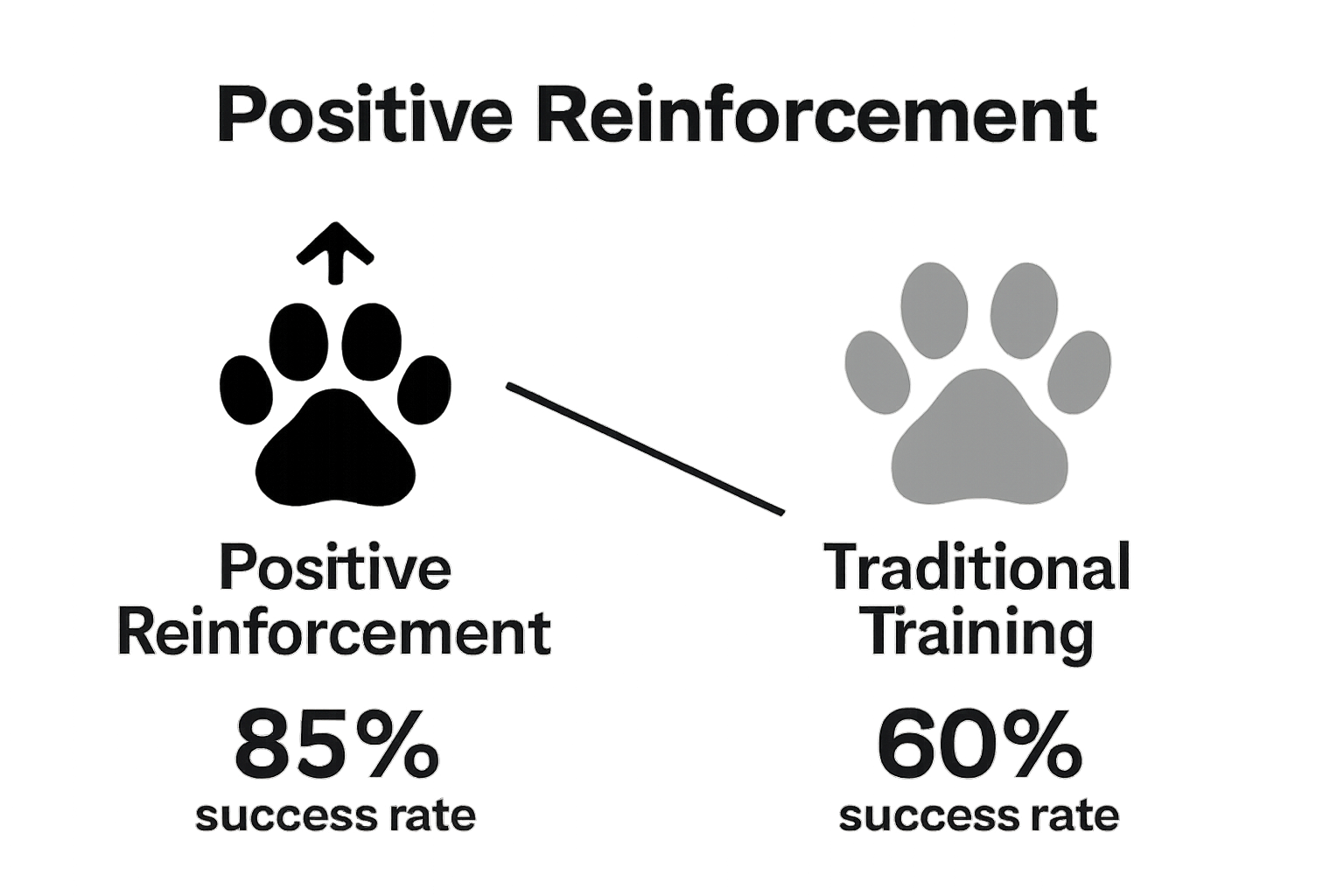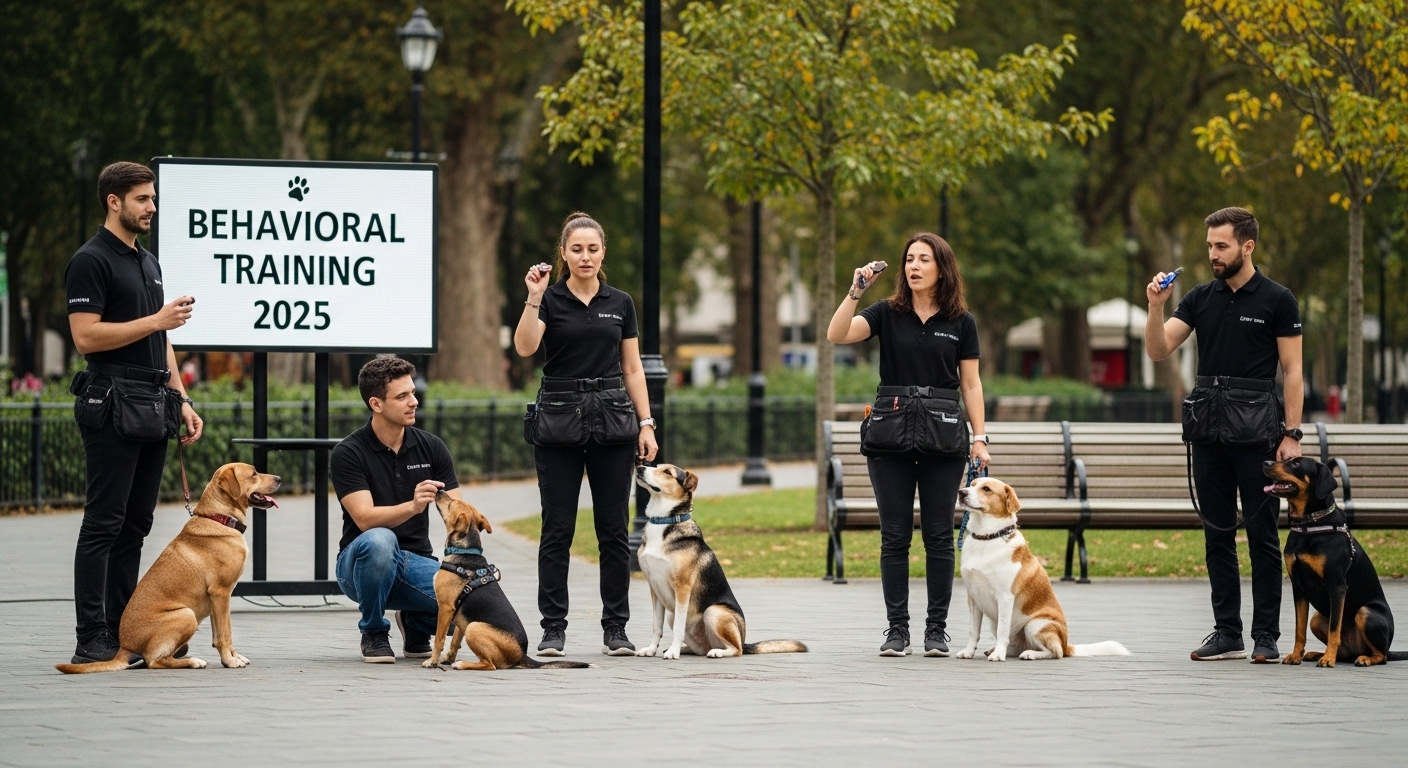Dog training in 2025 looks nothing like what most people grew up with. Interactive training apps have been shown by University of Lincoln researchers to significantly reduce problematic behaviors in dogs. Surprised? Most assume a bag of treats and a firm voice are all you need. Instead, the real breakthroughs are coming from AI powered technology that learns how your dog thinks and tailors lessons to each furry student.
Table of Contents
- What Are The Latest Trends In Dog Training For 2025?
- Why Do Dog Training Trends Matter For Owners And Trainers?
- How New Technologies Are Shaping Dog Training Approaches
- Key Principles Behind Positive Reinforcement And Behavior Modification
- Real-World Impact Of Dog Training Trends On Pet Ownership
Quick Summary
| Takeaway | Explanation |
|---|---|
| Embrace technology for training | Utilize apps and smart devices to enhance dog training programs with precise, data-driven strategies. |
| Prioritize social learning techniques | Incorporate group sessions to allow dogs to learn from each other, improving social skills and emotional intelligence. |
| Focus on positive reinforcement | Use rewards effectively to encourage desired behaviors, fostering a collaborative learning environment. |
| Understand individual dog needs | Tailor training approaches to accommodate each dog’s unique temperament and learning style for better outcomes. |
| Enhance owner-dog communication | Deepen the human-canine bond by adopting new training strategies that reduce misunderstandings and improve interactions. |
What Are the Latest Trends in Dog Training for 2025?
Dog training is experiencing a transformative phase in 2025, driven by technological advancements, deeper understanding of canine psychology, and more personalized approaches to behavior modification. These emerging trends are reshaping how dog owners and professionals approach training, emphasizing communication, mental stimulation, and holistic development.
Technology Meets Canine Learning
Digital platforms and smart devices are revolutionizing dog training methodologies. Research from the University of Lincoln reveals that interactive training apps can significantly reduce problematic behaviors by providing structured, engaging learning experiences. Modern dog training now incorporates:
- AI powered behavior tracking systems
- Virtual training modules
- Personalized training recommendations based on individual dog profiles
These technological solutions enable more precise, data driven training strategies that adapt to each dog’s unique learning style and behavioral patterns.
To help clarify how current technologies are influencing dog training, the following table contrasts traditional approaches with modern, tech-enhanced strategies discussed in the article.
| Training Approach | Key Features | Advantages | Limitations |
|---|---|---|---|
| Traditional Methods | Voice commands, treat rewards, repetition | Familiar, low-tech, accessible | Less personalized, progress is harder to track |
| AI-Powered Training Apps | Behavior tracking, adaptive lessons, instant feedback | Data-driven, highly customizable | Requires devices and internet access |
| Smart Devices (Wearables, Dispensers) | Activity/stress monitoring, automated reward delivery | Real-time insights, encourages engagement | May require investment and setup |
| Group/Social Learning Sessions | Structured interaction with other dogs | Boosts social skills, naturalistic learning | Needs supervision, may not suit all dogs |
Observational and Social Learning Approaches
Trainers are increasingly recognizing the importance of social learning in dog training. According to studies in animal behavior, dogs learn extensively through observation and interaction with other dogs. This insight has led to training methods that incorporate:
- Group training sessions
- Controlled socialization environments
- Structured interactions with well behaved dogs
By mimicking natural pack learning dynamics, these approaches help dogs develop better social skills and emotional intelligence.
If you want to dive deeper into understanding modern dog training techniques, read our comprehensive guide on dog behavioral training.
Why Do Dog Training Trends Matter for Owners and Trainers?
Dog training trends are not merely passing fads but critical developments that directly impact the quality of life for both dogs and their human companions. Understanding these trends provides owners and trainers with essential insights into more effective, compassionate, and scientifically grounded approaches to canine behavior and learning.
Enhancing Communication and Understanding
Modern dog training trends emphasize building deeper relationships between dogs and humans through improved communication strategies. Research from Oregon State University highlights how effective training can create meaningful interactions that go beyond basic obedience. Key benefits include:
- Reducing misunderstandings between dogs and owners
- Creating more predictable and stable home environments
- Developing stronger emotional connections
By understanding emerging training methodologies, owners can transform potential behavioral challenges into opportunities for mutual growth and understanding.
Economic and Practical Implications
Staying current with dog training trends offers significant practical advantages. Professional trainers and dog owners who adapt to new techniques can prevent costly behavioral issues, reduce veterinary expenses, and minimize potential property damage. These trends often incorporate:
- Cost effective training solutions
- Preventative behavioral modification techniques
- Advanced diagnostic tools for understanding canine psychology
Moreover, contemporary training approaches recognize that each dog is unique, requiring personalized strategies that respect individual temperaments and learning styles.
If you want comprehensive insights into modern training techniques, check out our expert dog obedience training guide that breaks down the latest professional strategies for 2025.
How New Technologies Are Shaping Dog Training Approaches
Technological innovations are dramatically transforming dog training approaches, creating more sophisticated, personalized, and data driven methods for understanding and modifying canine behavior. These advancements are not just changing training techniques but fundamentally reimagining the relationship between dogs and their human companions.
Artificial Intelligence and Machine Learning
Researchers at North Carolina State University have developed groundbreaking systems that combine sensors and intelligent software to monitor and train dogs autonomously. Modern AI powered technologies now enable:
- Real time behavior analysis
- Automated training feedback mechanisms
- Personalized learning pathways for individual dogs
These intelligent systems can track minute behavioral nuances, providing unprecedented insights into canine psychology and learning patterns.
Smart Devices and Interactive Training Tools
The emergence of smart training devices has revolutionized how owners interact with and train their dogs. Cutting edge technologies now include:
- Automated treat dispensers with behavior recognition
- Wearable devices tracking dog activity and stress levels
- Interactive training platforms with adaptive learning algorithms
These technologies transform training from a manual process to an intelligent, data driven experience that adapts to each dog’s unique learning style and behavioral characteristics.
If you are interested in exploring the latest training techniques, check out our comprehensive guide on smart dog training tips that breaks down emerging technologies and strategies.
Key Principles Behind Positive Reinforcement and Behavior Modification
Positive reinforcement represents a revolutionary approach to dog training that focuses on encouraging desired behaviors through strategic rewards and emotional connection. By understanding the psychological mechanisms behind this method, owners can create more meaningful and effective training experiences for their canine companions.
The Science of Reward Based Learning
According to the American Kennel Club, positive reinforcement is grounded in operant conditioning principles where behaviors followed by positive outcomes are more likely to be repeated. This scientific approach involves:
- Identifying specific desired behaviors
- Providing immediate rewards after correct actions
- Consistently reinforcing positive behavioral patterns
The core philosophy is simple yet powerful: dogs will naturally gravitate towards behaviors that result in pleasant consequences, making learning a collaborative and enjoyable process.

Emotional Intelligence and Behavioral Modification
Modern dog training transcends simple command response, recognizing dogs as complex emotional beings. Positive reinforcement techniques focus on building trust, reducing anxiety, and creating a supportive learning environment. Key strategies include:
- Using varied reward types (treats, praise, play)
- Maintaining calm and consistent training atmospheres
- Recognizing and responding to individual dog personalities
By understanding each dog’s unique emotional landscape, trainers can develop personalized approaches that respect the animal’s psychological needs and learning capabilities.
If you want to explore more about understanding canine learning processes, check out our comprehensive guide on how dogs learn that breaks down the latest scientific insights.
Real-World Impact of Dog Training Trends on Pet Ownership
Dog training trends are fundamentally reshaping the relationship between humans and their canine companions, extending far beyond traditional obedience techniques. These evolving approaches are transforming how pet owners perceive, interact with, and integrate dogs into their daily lives, creating more holistic and meaningful connections.
Expanding Social and Professional Integration
According to the American Pet Products Association, modern dog training trends are driving unprecedented social integration. Pet owners are increasingly taking their dogs on daily errands and incorporating them into professional and personal environments. This shift is characterized by:
- Enhanced socialization skills for dogs
- Greater workplace and public space acceptance
- Increased opportunities for dog-human interaction
These developments reflect a broader cultural recognition of dogs as intelligent, adaptable companions capable of navigating complex social scenarios.
Economic and Lifestyle Transformations
Modern training methodologies are generating significant economic and lifestyle impacts. Dogs trained using contemporary techniques are more likely to become active participants in their owners’ lives, influencing consumer behaviors and personal experiences. Key transformations include:
- Increased consumer spending on pet experiences
- More flexible lifestyle accommodations for dogs
- Higher quality of life for both pets and owners
Training is no longer about control but about creating mutual understanding and shared experiences that enrich both human and canine lives.
This table summarizes the real-world impacts of modern dog training trends on both pet owners and their canine companions, as described in the article.
| Impact Area | Description | Benefit to Owners | Benefit to Dogs |
|---|---|---|---|
| Social Integration | Greater acceptance in workplaces and public spaces | More flexibility in daily routines | More opportunities for socialization |
| Economic/Lifestyle Changes | Increase in consumer spending on pet experiences | Enriched lifestyles, new activities | Higher quality of life |
| Communication & Understanding | Improved owner-dog interaction and trust | Deeper bonds, reduced confusion | Less anxiety, more predictable routines |
| Personalized Learning | Tailored training matching individual dog personalities | More effective, cost-efficient | Emotional well-being, faster learning |

If you want to explore the comprehensive benefits of these emerging training approaches, discover our in-depth guide on dog training benefits that explains how modern techniques can transform pet ownership.
Make Dog Training Trends Work for Your Home and Your Dog
Are you feeling overwhelmed by new dog training trends and looking for solutions that offer real safety, independence, and communication for both you and your dog? The article highlighted how technology, personalized learning, and positive reinforcement are transforming how we care for our pets. But knowing these trends is just the first step. If you want to truly bridge the gap between what dogs need and how we interact with them every day, you need tools that help you apply these modern methods at home.

Now is the perfect time to experience the benefits of innovative training devices used by service dog handlers and proactive pet owners alike. The iPupPee alert device empowers you to take the next step by giving your dog a simple and reliable way to communicate. Whether you’re training a new puppy or supporting a loved one with special needs, iPupPee puts cutting-edge trends into practice. Visit https://ipuppee.com and discover how you can transform daily challenges into opportunities for safety, connection, and peace of mind. Want to learn more about how our device supports your unique training journey? Explore additional success stories and training resources on our blog. Take action today and let your dog’s voice be heard.
Frequently Asked Questions
What are the main trends in dog training for 2025?
The key trends in dog training for 2025 include the integration of technology through interactive apps and smart devices, a focus on observational and social learning, and an emphasis on personalized training strategies tailored to individual dogs’ needs.
How does technology improve dog training methods?
Technology enhances dog training by providing tools such as AI-powered behavior tracking systems, automated feedback mechanisms, and interactive training platforms, which allow for personalized and data-driven approaches to understanding and modifying canine behavior.
Why is positive reinforcement important in modern dog training?
Positive reinforcement is crucial because it encourages desired behaviors by rewarding them, thereby making the learning process more enjoyable and effective for dogs. This method fosters trust and emotional connections between dogs and their owners.
How do trends in dog training impact pet ownership?
Current trends in dog training enhance the quality of life for both dogs and their owners by promoting better communication, socialization skills, and overall integration of dogs into personal and professional environments, thereby enriching their daily experiences.

